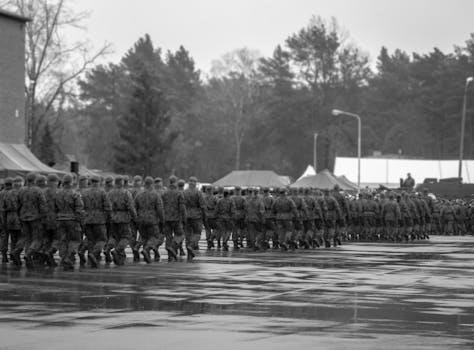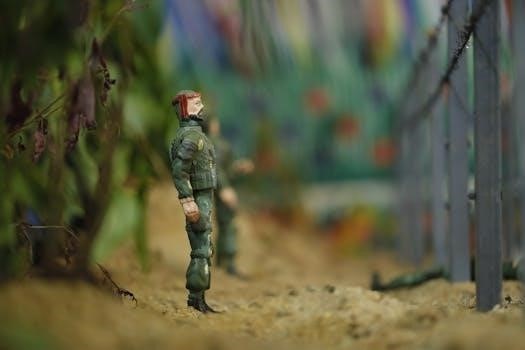Ground Guide Signals in the Army⁚ An Overview
Ground guide signals are a vital communication method in the Army, primarily using hand and arm movements to direct vehicle operations. These signals are crucial for safety, especially in confined spaces or areas with limited visibility. They ensure precise and coordinated movement of military vehicles.
Common Hand and Arm Signals for Guiding Vehicles
The Army employs a standardized set of hand and arm signals to effectively guide vehicles, ensuring clear communication between the ground guide and the driver. These signals are fundamental for maneuvering vehicles safely, particularly in challenging environments. A common signal involves extending the arm with the palm down, pointing in the direction of movement, indicating the path the driver should take. Another signal uses a vertical forearm with the forefinger pointing up, moving the hand in a small circle, which often signifies that the vehicle should move forward. To halt the vehicle, the guide typically extends both arms with palms down. These core signals are crucial for basic vehicle control and are consistently used across various situations. These signals are also used for directional control by pointing the arm in the direction that the driver should turn the wheels. Shaking the pointing hand indicates a larger turn, and the stop signal ends any turning maneuver. Consistency and clarity in these signals are paramount for safe operations.
Dismounted Ground Guide Signals
Dismounted ground guide signals are specifically designed for situations where personnel are on foot, directing vehicle movements from outside the vehicle. These signals are critical for maintaining safety and order, especially in areas where space is limited or visibility is poor. The ground guide uses a combination of hand and arm movements to convey directions such as forward, stop, and turn instructions. These signals must be precise and easily understood, as any misinterpretation could lead to accidents or delays. The dismounted guide acts as the driver’s eyes in complex environments, using clear and consistent hand signals to navigate the vehicle. Because soldiers often have a weapon in one hand, the Army has developed signals to indicate numbers with just one hand. These dismounted signals provide a vital link between the guide and the vehicle operator, ensuring safe and efficient vehicle operations. The signals are generally used to communicate to either one element or several elements, to make sure that all the parts of the army are moving in a coordinated manner.
Use of Hand Signals for Tactical Vehicle Movement
Hand signals are indispensable for the tactical movement of military vehicles, particularly in scenarios where verbal communication is not feasible or safe. These signals facilitate the smooth and coordinated movement of vehicles during tactical operations. In assembly areas, harsh terrains, and limited visibility conditions, hand signals become the primary mode of communication between the ground guide and the vehicle operator. The precision and clarity of these signals are paramount to avoid accidents and ensure the efficiency of the movement. Using these signals, ground guides can direct vehicles through complicated routes, around obstacles, or into specific positions. The signals also include a variety of commands beyond basic movement, such as controlling the speed and making turns. The ground guide must have a comprehensive understanding of all signals and use them accurately. The hand signals ensure that vehicles can move safely and effectively in diverse and challenging environments. The use of hand signals is also critical in tactical situations where radio silence is necessary.


Specific Ground Guide Hand Signals
Specific hand signals in the Army are designed for clear and unambiguous communication. These signals cover directions, movement, and numerical indicators. They ensure precise vehicle control during tactical maneuvers by using standardized hand and arm movements.
Directional Signals⁚ Turning the Wheels
In the realm of ground guide signals within the Army, directional commands for turning vehicle wheels are essential for precise maneuvering. These signals are communicated using distinct hand and arm gestures that clearly indicate to the driver which way to steer. A fundamental signal involves extending the arm in the direction where the wheels should turn; this pointed arm serves as a visual guide. To indicate a more significant turn, the ground guide will shake their pointing hand to tell the driver to increase the wheel’s turning angle. Conversely, the stop signal, a universal gesture, is used to halt any ongoing turn. These gestures are critical for ensuring the safe and efficient navigation of military vehicles in various environments, from open areas to confined spaces. The clarity and precision of these signals are paramount to avoid accidents and maintain operational effectiveness, with a focus on clear and concise movements.
Signals for Movement⁚ Forward, Stop, and Reverse
Within the Army’s ground guide signal system, specific hand and arm signals dictate the movement of vehicles, covering forward motion, halting, and reversing. To signal forward movement, the ground guide extends their arm with the palm down, pointing in the direction the vehicle should proceed. This clear, linear gesture is easy to interpret, ensuring the driver knows the intended direction. For stopping, the universal stop signal is employed, which involves extending both arms with palms down. This signal is a clear indication for the driver to immediately halt the vehicle’s progress. Reversing signals, while not explicitly detailed in the immediate context, typically involve specific hand and arm movements indicating the rearward direction the vehicle should move. These signals are crucial for maintaining a coordinated and safe movement. The precision and clarity of these signals are vital for preventing accidents. The usage of these signals allows for effective communication between the ground guide and the vehicle operator.
Hand Signals for Indicating Numbers
The Army utilizes a specialized set of hand signals to communicate numbers, particularly useful when one hand might be occupied, such as when holding a weapon. This system allows for numerical communication with a single hand, ensuring clarity even in situations where the ground guide’s movements are limited. These signals are essential for relaying information about the distance to move, the number of vehicles in a convoy, or other numerical data crucial to tactical maneuvers. This method is designed to be easily understood by the driver, ensuring smooth execution of the required movements. The simplicity of these signals and the need for only one hand makes them incredibly practical in dynamic military scenarios. These hand signals are critical for maintaining efficiency and accuracy in all operations. This system of signaling numbers is a fundamental part of ground guide training. This ensures that all soldiers are well versed in how to use it. It is essential for clear communication.

Importance and Context of Ground Guide Signals
Ground guide signals are paramount for safety, especially during tactical vehicle movements in various conditions. They provide essential communication, preventing accidents in challenging terrains and limited visibility, ensuring smooth operation and soldier safety.
Safety Considerations and Preventing Accidents
The use of ground guide signals is deeply rooted in the safety protocols of the Army, aiming to prevent accidents during vehicle maneuvers. Proper understanding and execution of these signals are crucial, as failure to do so can lead to serious injuries or even fatalities. Ground guides are fully responsible for the safe movement of vehicles, ensuring that all personnel are clear of the vehicle’s path. Before any movement, both the driver and the ground guide must have a clear understanding of the signals. In congested or confined areas, using dismounted ground guides is essential for safe vehicle operation, minimizing risks to personnel. The signals are particularly important in limited visibility or harsh terrain, where visual cues are difficult to interpret. Clear and precise hand signals are essential for avoiding collisions with obstacles, other vehicles, or personnel. Moreover, maintaining a mirror image of signals between multiple guides is critical, ensuring consistent directions. Therefore, adequate training in ground guide signals is vital to maintaining safety.
Use in Various Terrains and Visibility Conditions

Ground guide signals are essential across diverse terrains and under varying visibility conditions, ensuring safe vehicle movement. In harsh terrains, where obstacles and uneven surfaces are common, hand signals provide precise guidance, helping drivers navigate safely. These signals become especially critical when visibility is limited, such as in dusty environments, at night, or in dense fog. When visual cues are diminished, the reliance on clear, unmistakable hand signals becomes even greater. The ground guide acts as the driver’s eyes in these challenging situations, ensuring that the vehicle avoids hazards. The ability to communicate effectively through hand signals in such conditions minimizes the risk of accidents and vehicle damage. Moreover, the adaptability of hand signals means they can be used in different tactical scenarios, from assembly areas to confined urban settings. This versatility is vital for maintaining operational effectiveness in any environment, ensuring that vehicles can move safely regardless of the terrain or visibility.
Ground Guide Communication and Mirror Imaging
Effective ground guide communication relies on clear, distinct hand signals that are universally understood within the Army. The primary ground guide is often supported by secondary guides, especially for large or complex vehicle movements. A key aspect of this communication is mirror imaging, where the rear ground guide mirrors the signals of the primary guide to ensure the driver understands the intended direction, especially when the vehicle is long. This system ensures the driver can see the signals regardless of the vehicle’s configuration or their position. Mirror imaging enhances clarity and precision. It is important that all ground guides maintain a clear line of sight with both the driver and each other, allowing for seamless communication and swift adjustments during vehicle movement. The effectiveness of these techniques is essential for preventing accidents and damage, as it provides consistent and reliable communication even in noisy or chaotic environments. Mirroring ensures a cohesive and synchronized approach to vehicle guidance;